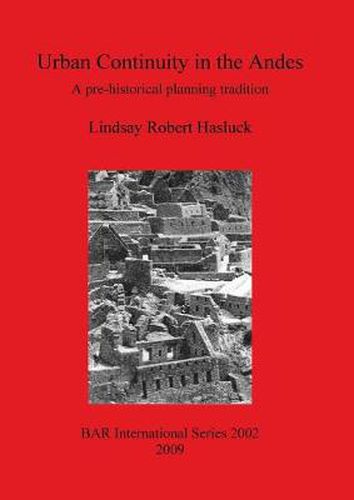Readings Newsletter
Become a Readings Member to make your shopping experience even easier.
Sign in or sign up for free!
You’re not far away from qualifying for FREE standard shipping within Australia
You’ve qualified for FREE standard shipping within Australia
The cart is loading…






This title is printed to order. This book may have been self-published. If so, we cannot guarantee the quality of the content. In the main most books will have gone through the editing process however some may not. We therefore suggest that you be aware of this before ordering this book. If in doubt check either the author or publisher’s details as we are unable to accept any returns unless they are faulty. Please contact us if you have any questions.
This work investigates the evolution of urban design in the Andes of South America to ascertain if there existed in pre-Hispanic times a shared Andean tradition of urban planning. Since, in previous research, Andean urban planning has been treated as the product of individual sites or cultures, this study explores the repeated use of design elements within Andean urban planning, in order to isolate specific elements for individual functional analysis within the context of a cultural tradition. The primary focus is to demonstrate clearly the urban design connection that forms a coherent Andean urban planning tradition shared between the urban civilizations of the Andes from the inception of urbanism around the beginning of the third millennium BC until the cultural disruption of the Spanish conquest in the mid-sixteenth century AD. Through the investigation and understanding of the evolving sophistication of the cultures within the Andes cultural, political and geographical region, the study demonstrates that certain ideas of urban design, from very early times, began to form a coherent planning tradition that was shared by civilizations, cultures and settlements in close and distant contact. Moreover, these ideas for architectural designs and layouts for urban areas were not only shared geographically but also repeated through time.
$9.00 standard shipping within Australia
FREE standard shipping within Australia for orders over $100.00
Express & International shipping calculated at checkout
This title is printed to order. This book may have been self-published. If so, we cannot guarantee the quality of the content. In the main most books will have gone through the editing process however some may not. We therefore suggest that you be aware of this before ordering this book. If in doubt check either the author or publisher’s details as we are unable to accept any returns unless they are faulty. Please contact us if you have any questions.
This work investigates the evolution of urban design in the Andes of South America to ascertain if there existed in pre-Hispanic times a shared Andean tradition of urban planning. Since, in previous research, Andean urban planning has been treated as the product of individual sites or cultures, this study explores the repeated use of design elements within Andean urban planning, in order to isolate specific elements for individual functional analysis within the context of a cultural tradition. The primary focus is to demonstrate clearly the urban design connection that forms a coherent Andean urban planning tradition shared between the urban civilizations of the Andes from the inception of urbanism around the beginning of the third millennium BC until the cultural disruption of the Spanish conquest in the mid-sixteenth century AD. Through the investigation and understanding of the evolving sophistication of the cultures within the Andes cultural, political and geographical region, the study demonstrates that certain ideas of urban design, from very early times, began to form a coherent planning tradition that was shared by civilizations, cultures and settlements in close and distant contact. Moreover, these ideas for architectural designs and layouts for urban areas were not only shared geographically but also repeated through time.